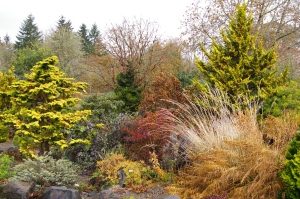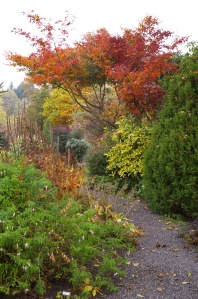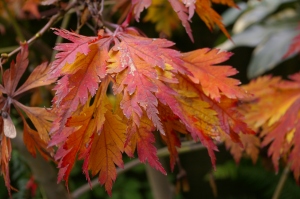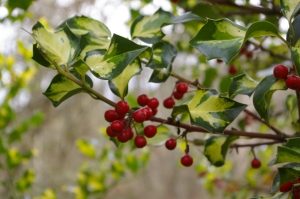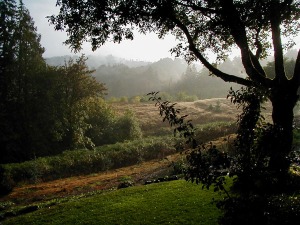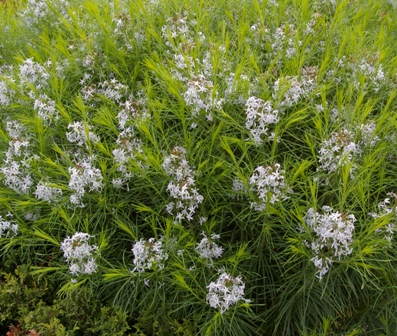Some gardeners are afraid of large herbaceous perennials because they leave gaping holes when they go dormant in the winter. In the maritime climate of the Pacific Northwest where we are blessed with relatively mild weather and can easily achieve an all-but evergreen garden, this is perhaps a relevant complaint.
That said, there is still the sheer thrill of growing herbaceous perennials for the sense of seasonal change they give us. Among the very easiest of underused and very hardy herbaceous perennials are the Bluestars, genus Amsonia. At Joy Creek Nursery, we have been growing these delightful, billowing plants for almost twenty years. The tongue-tying species Amsonia tabernaemontana var. salicifolia was our introduction to the genus. (By the way, A. tabernaemontana is commonly calledWillow bluestar and it is odd that the varietal name also means “willow-like foliage.” Perhaps this is simply to amplify our understanding of its appearance.) From there we graduated to A. illustris and later to A. cilliata and A. hubrechtii. Along the way we tried to grow the dry-land species Amsonia peblesii from seed but did not have much luck. We have only grown the North American species although there are species from Asia, Europe and theMiddle East as well.

Amsonia huprectii
These are not plants like lilies that announce their arrival with large blaring trumpets. They are much subtler than that. Their stems emerge in early spring from well-developed clumps much as those of milkweeds do. (In fact, the common name for one species is blue milkweed.) Instead of trumpets, the willowy, upright stems bear constellations of small soft blue stars in panicles at their tips. The blooms arrive in late spring or early summer depending on the species. During the course of the summer, the fertilized flowers form numerous long, narrow, papery seed pods that are also of interest.
The foliage and height of these various species is what makes them distinct from one another. A. tabernaemontana has fairly broad leaves that are up to three inches long. In our garden, it stands four feet tall or better. A. Illustris is also in the four foot range with similar lance-shaped leaves. A. ciliata (called the Blue milkweed) has much narrower leaves and it ascends to three feet or more. (There is a selection from this species called ‘Halfway toArkansas’ that is much shorter than the species and has slightly broader foliage.) Of all of the forms we grow, A. hubrechtii, from the central to the northeast part of the States, has the most feathery foliage. This plant only gets to about three feet.
All of these species have lovely fall color. The more sun they get, the more pronounced their transformations. Generally, their leaves turn yellow, but in A. tabernaemontana, A. illustris, and even somewhat in A. ciliata, there is also bronze and a little purple in the mix. A. hubrechtii seems to turn uniformly golden in our garden.

Amsonia ‘Halfway to Arkansas Fall Color
Amsonia do not ask much more than average summer water. Over time our specimens have become somewhat drought tolerant. Further, we have never had to down-size our plants although it did take several years for them to develop into generous clumps. We use them in the background and as specimen plants. Their stems move gracefully in the wind. Their flowers are attractive to pollinators and birds and they offer us a sense of the changing season from spring green through delicate bloom and brilliant autumn coloration to winter dormancy.
Maurice
